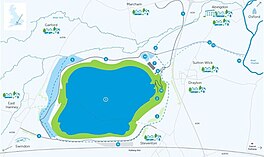Abingdon Reservoir
 From Wikipedia the free encyclopedia
From Wikipedia the free encyclopedia
| Abingdon Reservoir | |
|---|---|
 2023 Illustration by Thames Water of the conceptual design and location for a 150 Mm3 reservoir.[1] | |
| Location | Oxfordshire |
| Coordinates | 51°38′04″N 1°21′15″W / 51.63444°N 1.35417°W |
| Lake type | Bunded reservoir (Proposed) |
| Primary inflows | River Thames |
| Primary outflows | River Thames |
| Basin countries | United Kingdom |
| Surface area | 6.7 km2 (670 ha; 1,700 acres) |
| Average depth | 22.4 m (73 ft) |
| Water volume | 150 million cubic metres (150 billion litres; 33 billion imperial gallons; 0.15 cubic kilometres; 0.036 cubic miles) |
The Abingdon Reservoir (also known as the South East Strategic Reservoir Option, or SESRO) is a long-term proposal for fresh water storage for the Home Counties. Located south west of Abingdon, Oxfordshire in the mid-west of the Thames Basin, it is intended to help support water supply provision in the south-east of England. The proposals have been developed with Southern Water and Affinity Water and is intended to serve all three company’s customers.[2]
Proposals
[edit]The proposal arose in 2006 by Thames Water.[3] In 2007 the Environment Agency opined that need for this was not proven.[4] Further arguments were put but the near-term-demand case was rejected in 2011.[5] In 2023, following a period of consultation, a revised version increased the proposal to 150 billion litres (150 million cubic metres; 33 billion imperial gallons).[6]
This would make Abingdon the second-largest reservoir in England by capacity, exceeded only by Kielder Water at 200 billion litres (200 million cubic metres; 44 billion imperial gallons), pushing Rutland Water into third place at 124 billion litres (124 million cubic metres; 27 billion imperial gallons). Across the whole of the UK, only seven Scottish lochs have greater freshwater storage by volume.
Since 2018, a longer-term proposal stands, for its building, by 2043 to cater to projected population growth in the Thames Basin.[7][8]
Reasons for the construction
[edit]The main reason to build is that the South-East is facing significant seasonal water stress. Factors are the rain shadow behind the prevailing westerly winds and western hills. Eastern counties lack the rainfall of the west; their average annual rainfall being 500-750mm. The west receives around 1800-2800mm.
Average population density is higher in the eastern than western counties; London houses 13.5% of the UK's population. This is the greatest concentration of domestic water usage. Roughly 22% of water use is domestic; 75% is from all types of industry.[citation needed]
Counter-arguments
[edit]GARD or the 'Group Against Reservoir Development' have counter-arguments, local, national, and international comparators.[9]
- Thames Water have unambitious targets for leakages[9]
- The reservoir will be far from potent against long droughts[10]
- As there is enough water to supply London now there can be in future using other, sustainable methods.[9]
- Impacts on the ecosystem being transformed from supporting many endangered and protected land-based invertebrates, water voles, bats and hedgehogs to more water-based bird life.[9]
- Traffic congestion and construction pollution.[9]
- Local economic loss of many well-rooted businesses and a solar farm.[11][9]
- A new, low, risk of flooding.[9]
References
[edit]- ^ "New reservoir in Abingdon | Water resources". Thames Water. Retrieved 2023-09-08.
- ^ "South East Strategic Reservoir Option (SESRO) – a new reservoir for the south east". Thames Water Resources Management Plan. 2024-01-29. Retrieved 2024-03-05.
- ^ Reservoir 'biggest in 25 years' - BBC News, 14 September 2006
- ^ "Need for reservoir 'not proven'". BBC News. 5 January 2007. Retrieved 30 August 2009.
- ^ "Abingdon £1bn reservoir plan rejected by government". BBC News. 4 March 2011. Retrieved 7 May 2018.
- ^ Inman, Phillip (2023-04-22). "Lake or mistake? The row over water firms, drought and Abingdon's new super-reservoir". The Observer. ISSN 0029-7712. Retrieved 2023-09-12.
- ^ "Abingdon reservoir proposals questioned by Oxfordshire County Council". BBC News. 18 April 2018. Retrieved 7 May 2018.
- ^ "Abingdon Reservoir back on the cards!". CPRE. 19 February 2018. Retrieved 7 May 2018.
- ^ a b c d e f g http://www.abingdonreservoir.org.uk/ Group Against Reservoir Development. http://www.abingdonreservoir.org.uk
- ^ [1] Resilience - Final Report. Group Against Reservoir Development. http://www.abingdonreservoir.org.uk
- ^ East Hanney solar farm
External links
[edit]- Project homepage by Thames Water
